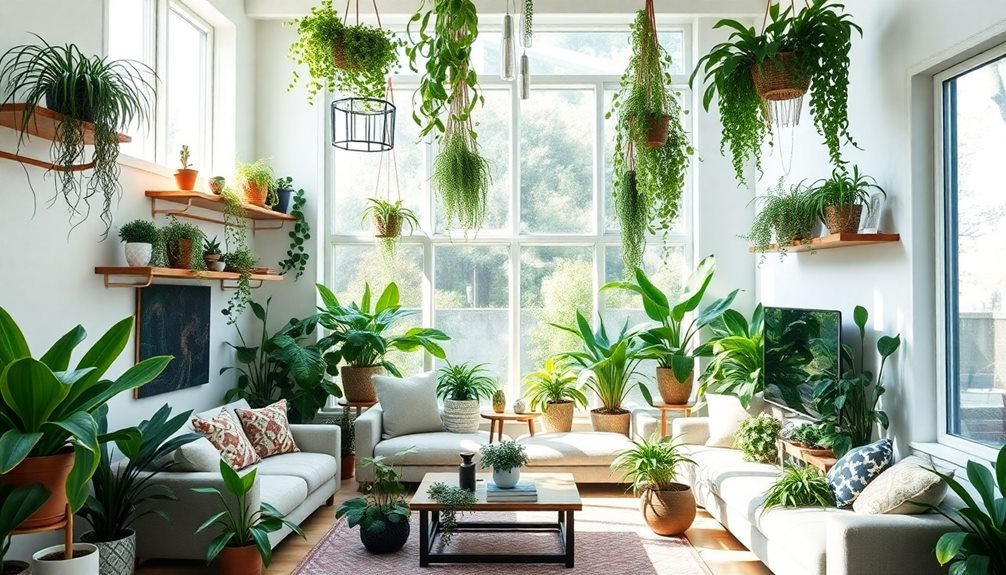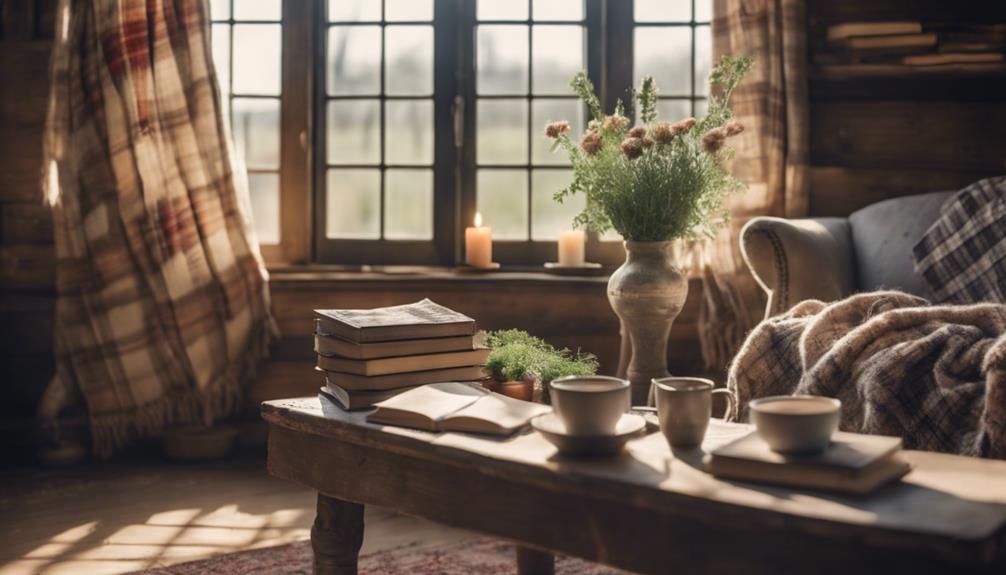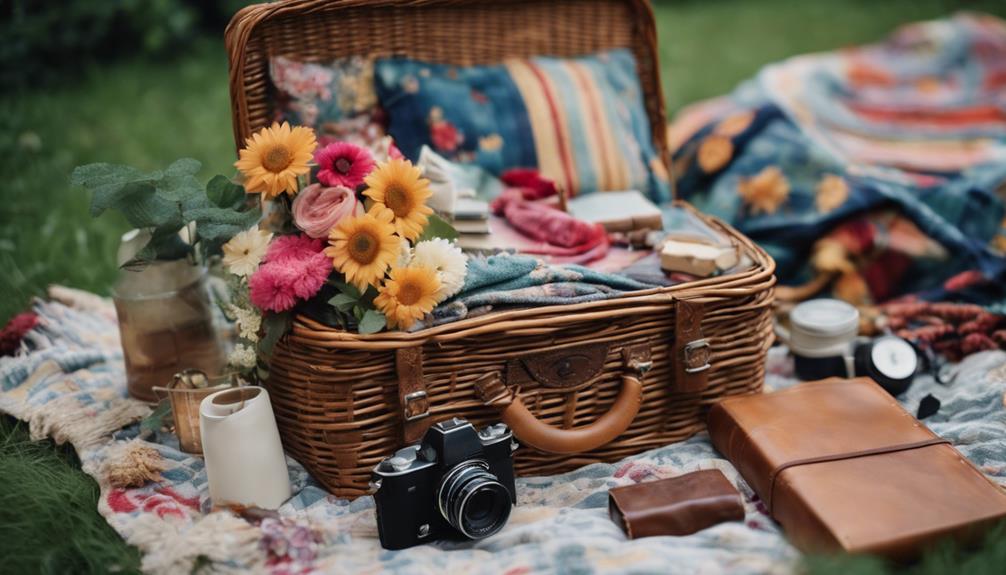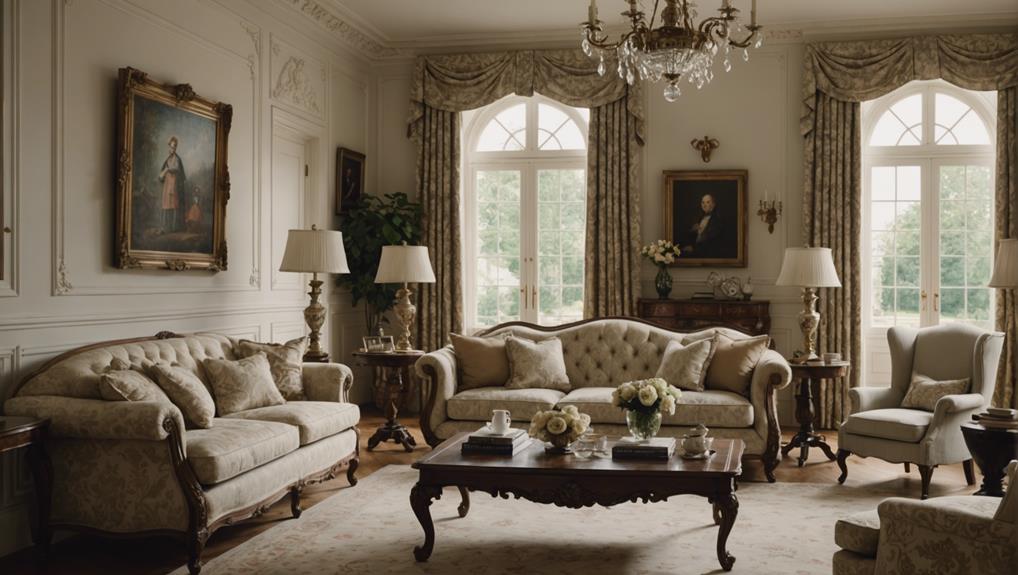Indoor plant styling can elevate your space, enhancing both beauty and air quality from floor to ceiling. Start by evaluating your light conditions and choosing the right plants that fit your room. Use creative display ideas, like wall-mounted planters and hanging plants, to maximize your vertical space. To personalize your style, mix unique pots and group plants in odd numbers for balance. Regular care, such as checking soil moisture and dusting leaves, will keep your plants thriving. Ready to transform your home into a lush oasis? There's plenty more to discover that can elevate your plant game even further!
Key Takeaways
- Utilize wall-mounted planters and shelves to maximize vertical space and showcase plants without cluttering the floor.
- Incorporate hanging plants to draw the eye upward, enhancing spatial perception and adding visual interest.
- Select decorative pots that align with your room's decor style for a cohesive aesthetic throughout the space.
- Group plants in odd numbers for balance and visual appeal, creating harmonious arrangements across different heights.
- Mix various plant species with unique shapes and textures to enhance dynamism and interest from floor to ceiling.
Benefits of Houseplants
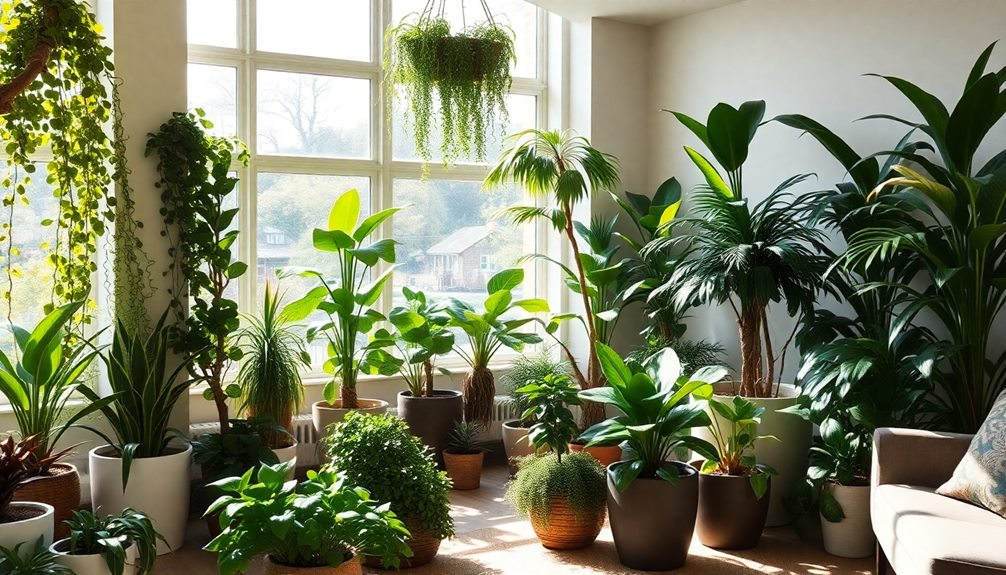
When you bring houseplants into your home, you're not just adding a touch of greenery; you're also reaping a multitude of benefits. One of the most significant advantages of houseplants is their ability to improve air quality. They filter out toxins like formaldehyde and benzene, enhancing your overall indoor health.
Additionally, certain houseplants are known to help reduce stress levels, making them a great addition to any home environment.
Furthermore, indoor plants can dramatically reduce stress levels. Studies show that having plants around can lower blood pressure and heart rate, leading to a more relaxed atmosphere.
With increased humidity from your plants, you'll also notice improvements in skin health and respiratory function, especially in dry environments.
Moreover, if you work from home, incorporating greenery in your workspace can boost productivity and concentration by as much as 15%. This simple addition to your home decor promotes a sense of well-being and connection to nature, which is linked to better mental health outcomes.
In short, the benefits of houseplants extend far beyond aesthetics. By choosing to include indoor plants in your living space, you're making a positive impact on your health and overall happiness.
Choosing the Right Plants

When you're choosing the right indoor plants, start by evaluating the light conditions in your space to find plants that thrive in those settings.
Next, think about the size of your area and how larger plants can make a statement versus how smaller ones can fit on shelves.
If you have pets, guarantee you pick non-toxic options to keep everyone safe while enhancing your home.
Assessing Light Conditions
Evaluating light conditions is often the most important step before choosing indoor plants. Understanding how light levels vary in your space helps guarantee your plants thrive.
Here's a quick guide to evaluating light conditions:
- Identify Direct vs. Indirect Light: Direct sunlight means at least 6 hours of bright light daily, while indirect light occurs in filtered spaces.
- Monitor Seasonal Changes: Light availability changes with the seasons. Keep an eye on how your plants respond throughout the year.
- Use a Light Meter: To get precise readings, consider using a light meter. This tool helps you measure the intensity of light in different areas.
- Observe Window Placement: Note how light enters through windows. South-facing windows receive the most light, while north-facing ones get less.
Plant Size Considerations
Selecting the right plants for your indoor space involves considering both the size of your room and the scale of your furniture. When you think about plant size considerations, larger plants like fiddle leaf figs can make a statement in spacious areas, while smaller plants such as succulents fit better in compact spaces.
Larger plants generally need more water due to their increased leaf surface area, making proper watering techniques vital for keeping them healthy. Aim for at least 6-8 inches of clearance around larger plants to guarantee airflow and prevent mold or disease.
To create visually appealing arrangements, group your plants in odd numbers, like three or five. This approach draws the eye and maintains balance in your decor.
Position tall plants in corners or next to large furniture pieces to anchor the space and avoid clutter. Smaller plants can easily find their home on shelves or tabletops, maximizing your use of space and time.
Pet-Friendly Options
Creating a vibrant indoor space while ensuring your pets are safe requires careful plant selection. You want to choose pet-friendly plants that enhance your home without putting your furry friends at risk.
Selecting plants can be similar to choosing eco-friendly toys for children, as both involve prioritizing safety and well-being. Here are four great options to take into account:
- Spider Plant: Known for its air-purifying qualities, this plant is non-toxic to both cats and dogs.
- Boston Fern: This lush, green option adds a touch of elegance and is safe for your pets.
- Parlor Palm: An excellent choice for low-light areas, this palm not only looks good but is also non-toxic.
- Bamboo Palm: With its tropical vibe, this palm improves air quality and is safe for your pets.
The American Society for the Prevention of Cruelty to Animals (ASPCA) offers a detailed list to help you identify toxic and non-toxic plants.
Remember, even pet-friendly plants can cause mild gastrointestinal upset if ingested in large quantities, so keep an eye on your pets' behavior around them.
Creative Display Ideas
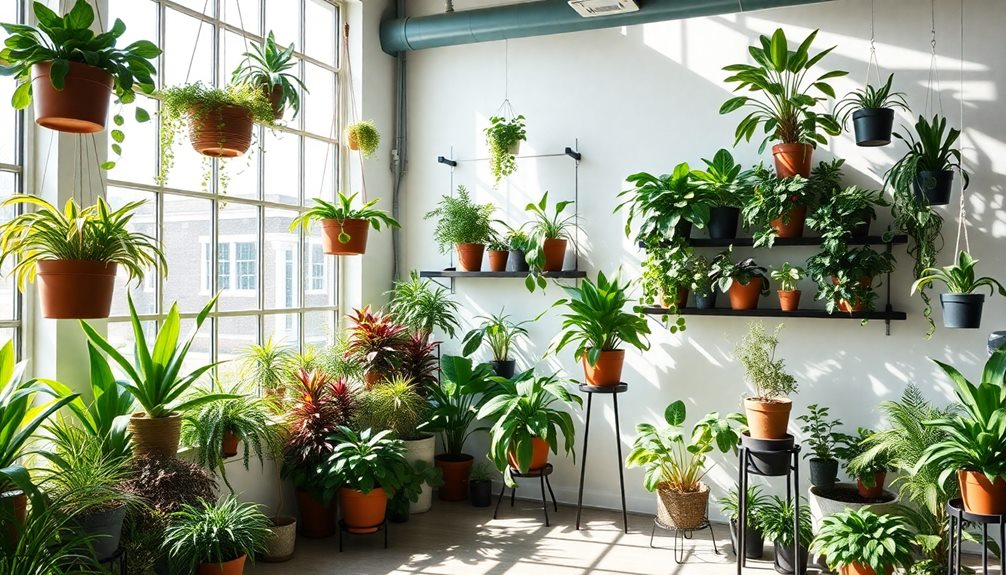
When it comes to displaying your plants, think vertically to maximize your space and create an eye-catching wall of greenery.
Unique containers, like repurposed jars or quirky pottery, can add personality and spark conversation.
Vertical Space Utilization
Maximizing vertical space is essential for transforming any indoor area into a vibrant sanctuary filled with greenery. You can creatively display your humble houseplants while ensuring your space feels open and inviting.
Here are some effective ideas:
- Wall-Mounted Planters: Utilize wall-mounted planters to showcase a variety of plants without sacrificing floor space. They create a stunning visual effect and can be arranged in patterns for added flair.
- Hanging Plants: Use plant hangers to suspend plants from ceilings or high shelves. This technique draws the eye upward, enhancing the sense of space and adding depth to your decor.
- Tiered Plant Stands: Incorporate tiered plant stands or ladders to arrange your plants at different heights. This not only maximizes light exposure but also makes it easier to care for your plants.
- Vertical Gardens: Consider creating a vertical garden or living wall. This bold design statement can transform a small area into a lush oasis while improving air quality.
Unique Container Ideas
Transforming your indoor space can be as simple as choosing the right containers for your plants. Unique container ideas can elevate your decor while showcasing your greenery. One way to achieve this is through upcycling everyday items like mason jars, tin cans, and wooden crates. These personalized plant containers not only add character but are also environmentally friendly.
Consider using decorative baskets for your potted plants. They add texture and make it easy to rearrange your space as needed. For a modern twist, incorporate terrariums made from glass containers. These eye-catching displays can create miniature ecosystems that draw attention.
Hanging planters crafted from macramé or repurposed materials can bring vertical interest to your home, especially in limited spaces. This allows your plants to thrive while creating a dynamic aesthetic.
Finally, think about integrating furniture with built-in planters, such as coffee tables or shelving units. This combination of functionality and style helps you utilize space effectively while showcasing your plants beautifully.
With these unique container ideas, you can transform your indoor environment into a lush oasis.
Vertical Space Utilization
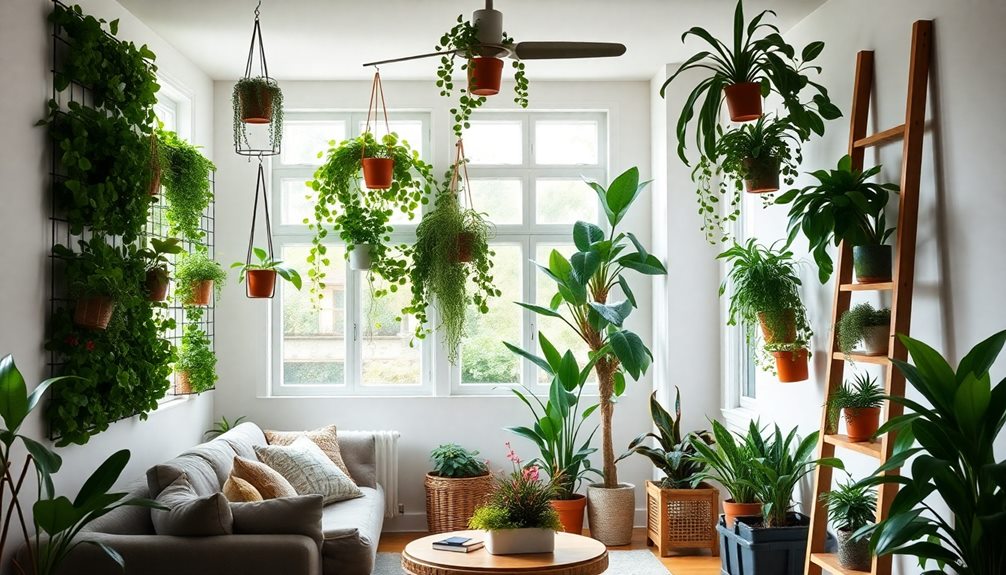
In recent years, utilizing vertical space in your home has become an essential strategy for adding greenery without cluttering your floors.
By incorporating plants in innovative ways, you can enhance the aesthetic of small rooms while also enjoying health benefits. Here are some effective methods to maximize vertical space:
- Wall-Mounted Planters: Install these to create stunning green accents on your walls. They're perfect for small spaces and can add a pop of color.
- Hanging Plants: Suspend plants from ceilings or walls to draw the eye upward. This not only creates dynamic visual interest but also makes your space feel larger and more open.
- Vertical Gardens: Consider a living wall to improve air quality and humidity while serving as a striking decor piece.
- Trellises for Climbing Plants: Use trellises or plant stands to support climbing plants, transforming bare walls into lush displays.
Indoor Plant Decor Trends
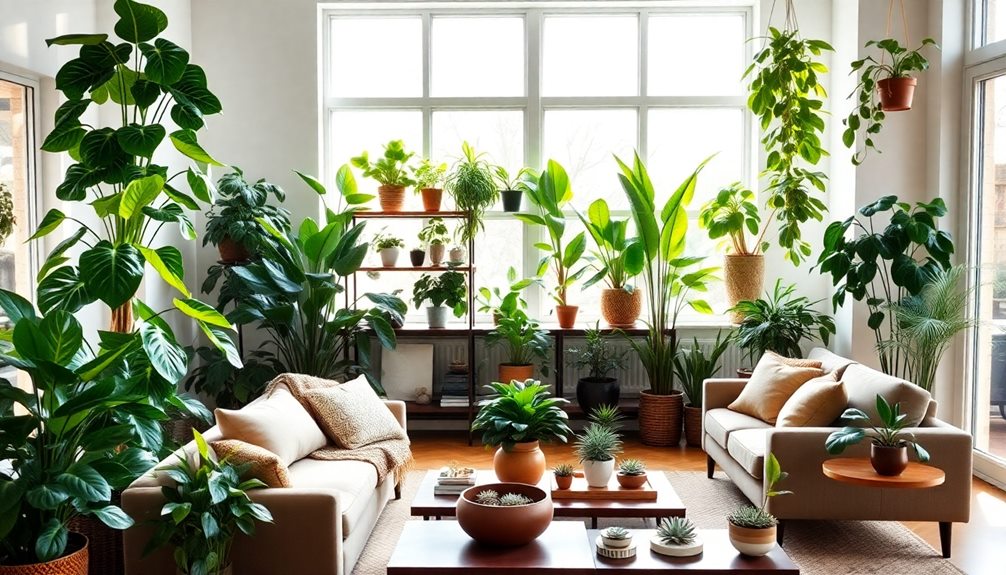
As you elevate your indoor plant game with vertical space utilization, it's also important to stay updated on the latest decor trends shaping how we incorporate greenery into our homes. A significant 70% of homeowners agree that indoor plant decor enhances their living spaces and overall ambiance.
Biophilic design principles are gaining popularity, emphasizing our connection to nature and inspiring urban jungle aesthetics that bring the outdoors inside.
DIY terrariums and vertical gardens are now trendy, allowing you to showcase your unique style while maximizing your space. These creative options not only look stunning but also make a statement about your personality and passion for plants.
Moreover, there's a surge in demand for rare and exotic houseplants, with online searches for unique species rising by 50% over the past year. This reflects a growing desire for distinctive indoor greenery that sets your space apart.
Finally, sustainable decor practices are on the rise, as 45% of consumers prefer upcycled planters and organic plant care products, aligning with the movement toward environmentally conscious living.
Embrace these trends to create a lush, inviting atmosphere in your home.
Care and Maintenance Tips
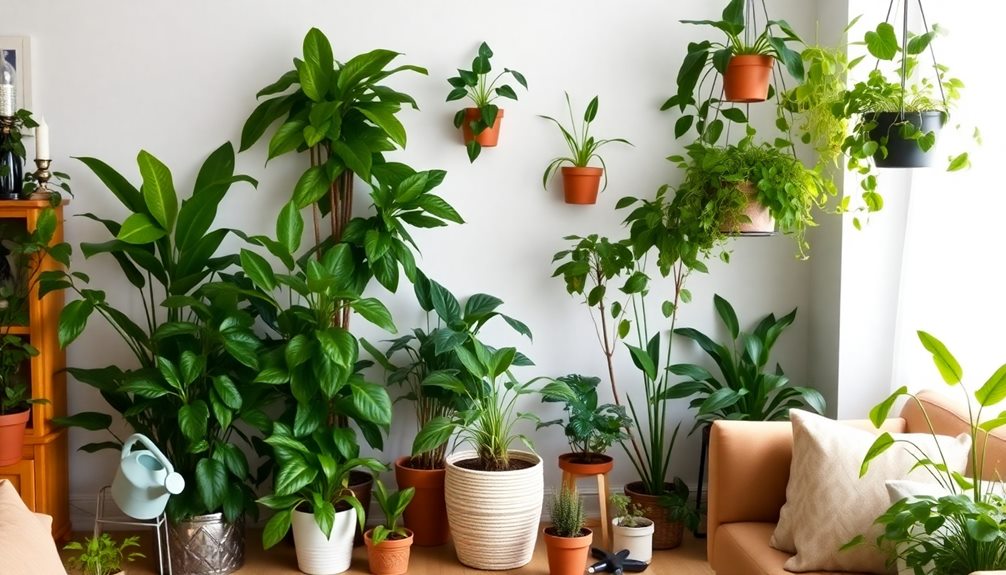
Caring for your indoor plants is essential to guaranteeing they thrive and enhance your living space. With the right care and maintenance, you can create an environment where your plants flourish. Here are some tips to keep in mind:
- Watering: Establish a consistent watering schedule by checking the top inch of soil for dryness. Most houseplants prefer to dry out slightly between waterings to prevent root rot.
- Soil: Use a well-draining potting mix tailored to your plant's needs. This guarantees adequate drainage and supports healthy root development.
- Dusting: Regularly dust the leaves with a damp cloth. This enhances photosynthesis and maintains plant health by preventing dust from hindering light absorption.
- Pruning: Prune dead or yellowing leaves as needed. This not only encourages new growth but also helps maintain a tidy appearance and prevents potential pest infestations.
Additionally, monitor light conditions and adjust plant placement accordingly.
Rotating your plants periodically will guarantee they receive even light exposure, promoting balanced growth.
With these simple steps, your indoor plants will thrive and bring life to your space.
Personalizing Your Plant Style
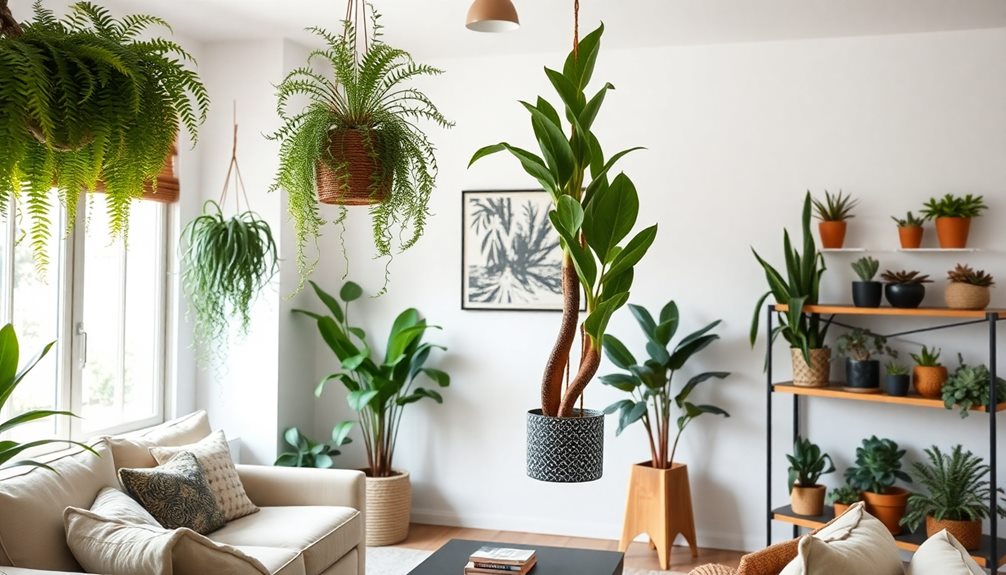
Transforming your indoor space with plants goes beyond simply choosing greenery; it's about expressing your personal style. Start by selecting species that resonate with you. For instance, spiky succulents offer a modern aesthetic, while lush ferns can create a tropical vibe. Mixing various leaf shapes and textures enhances visual interest, making your space more dynamic.
To elevate your plant displays, consider decorative pots that align with your room's color scheme. Modern geometric designs can complement contemporary decor, while rustic terra-cotta pots add a touch of warmth. Grouping plants in odd numbers—like three or five—creates a balanced arrangement that draws the eye.
Incorporating personal touches, such as handmade macramé hangers or repurposed vintage containers, allows for unique expressions of your style. Here's a quick reference to help you personalize your plant style:
| Plant Type | Aesthetic | Decorative Pot Style |
|---|---|---|
| Spiky Succulents | Modern | Geometric |
| Lush Ferns | Tropical | Rustic Terra-Cotta |
| Colorful Blooms | Bohemian | Vintage |
| Air Plants | Minimalist | Hanging Macramé |
Frequently Asked Questions
How Do I Safely Hang Plants From the Ceiling?
To safely hang plants from the ceiling, choose lightweight pots, use sturdy hooks, and guarantee they're anchored properly. Measure the height for ideal light, and regularly check for stability and moisture to avoid accidents.
What Are the Best Pots for Indoor Plant Styling?
When choosing pots for your indoor plants, consider materials like ceramic or terracotta for aesthetics and drainage. You'll want sizes that fit your plants comfortably, ensuring they have room to grow and thrive.
Can Indoor Plants Improve Air Quality Effectively?
You've probably heard that indoor plants can freshen up your space. It's true! They absorb toxins and release oxygen, effectively improving air quality. Just think of them as your little green air-purifying superheroes!
How Often Should I Rotate My Indoor Plants?
You should rotate your indoor plants every couple of weeks. This helps them grow evenly, preventing them from leaning toward light sources. Regularly changing their position keeps them healthy and vibrant throughout the year.
Are There Specific Plants That Thrive in Low Light?
When it comes to low light, you're in luck! Snake plants, pothos, and ZZ plants thrive beautifully. They're perfect choices, letting you enjoy greenery even in those not-so-sunny spots of your home.
Conclusion
As you fill your space with lush greenery, picture each plant as a vibrant brushstroke on the canvas of your home. From the cascading ivy draping elegantly from shelves to the tall, proud monstera reaching for the light, each choice elevates your environment. Embrace the joy of nurturing these living pieces of art, and let your indoor garden bloom into a personal sanctuary, where every leaf whispers stories of growth and tranquility. Your home deserves this touch of nature.
